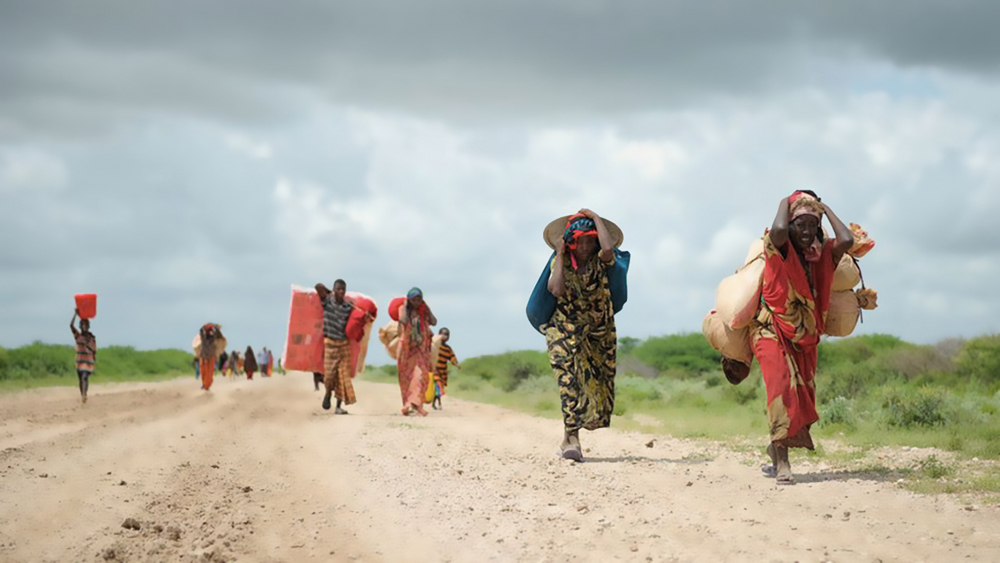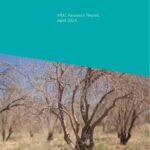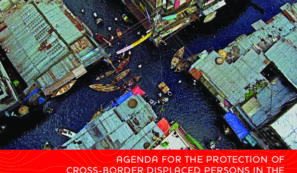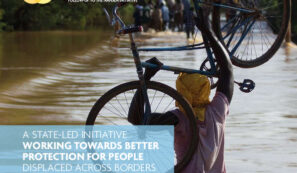
The Platform on Disaster Displacement: A State-led Initiative Working with Partners Towards Better Protection for People at Risk of or Being Displaced in the Context of Disasters and Climate Change
The PDD’s strategy is in line with the findings of the Nansen Initiative and, rather than advocating for the development of new legally binding standards and legal instruments for the protection of cross-border disaster-displaced persons at the global level, the PDD works with partners to promote better implementation of existing standards and legal instruments.
The PDD is a State-led multistakeholder partnership. It is led by a group of States (Steering Group), draws on the expertise and implementing capacity of a multistakeholder group of actors (Advisory Committee) and is supported by a Secretariat. A key working principle is strategic engagement with existing coordination mechanisms, and strong partnerships between States (policymakers and practitioners), international organizations, civil society representatives and researchers, in order to work towards collective outcomes. The PDD works closely with IOM and UNHCR, who are both standing invitees to its Steering Group as well as Advisory Committee members, and key partners regarding the implementation of the PDD Strategy and Workplan, in particular regarding the coordination and promotion of policy work globally and supporting initiatives at the regional and national level.
The PDD promotes a comprehensive approach to disaster displacement that aims at protecting disaster displaced persons as well as providing persons at risk of disaster displacement with measures helping them to stay or move safely out of harm’s way. This approach aligns with a human rights-based approach to disaster displacement as well as the objectives of the 2030 Agenda for Sustainable Development and its vision of a world in which ‘’no one will be left behind’’. The Platform’s overarching objective is “to support States and other stakeholders to strengthen the protection of persons displaced in the context of disasters and the adverse effects of climate change; as well as to prevent or reduce disaster displacement risks in countries of origin.”
The policy context
In line with the Platform’s 2024-2030 strategy, the Platform will support State efforts focusing on the following three strategic priorities:
- Enhance the implementation of measures to protect cross-border disaster-displaced persons.
- Enhance the management of the risk of disaster displacement in climate action, disaster risk reduction and sustainable development.
- Enhance public policies on planned relocation; as well as on internal disaster displacement and finding durable solutions.
In order to address these objectives and promote policy coherence across different fields and contexts, the PDD engages in relevant policy discussions and provides a range of awareness raising and capacity building activities.
One of the PDD’s strategic priorities is to support integrated implementation of global policy frameworks on human mobility, climate change action and disaster risk reduction that are relevant for disaster displaced persons. To do this, the PDD engages in relevant policy discussions and provides a range of awareness raising and capacity building activities. Human Mobility in the context of disasters and climate change has been addressed in the Sendai Framework for Disaster Risk Reduction 2015-2030, the 2016 Agenda for Humanity, the 2030 Agenda for Sustainable Development, the United Nations Framework Convention on Climate Change’s (UNFCCC) 2015 Paris Agreement that established the Task Force on Displacement (TFD), and the 2018 Global Compact for Safe, Orderly and Regular Migration (GCM) and Global Compact on Refugees (GCR), to name a few. These agreements recognize the need for cross-sectoral, coordinated action to address the diverse and region-specific challenges of human mobility in the context of disasters and climate change.
Since its establishment, the PDD has been working to frame and feed key messages about disaster displacement into relevant global policy frameworks and processes. To do this, the PDD as a state-led initiatives, draws from actions at regional and national levels, and provides evidence from relevant research to provide inputs and convene awareness raising activities.
The PDD does not advocate for the development of new legally binding standards and legal instruments but rather promotes and advocates for better implementation of existing standards and legal instruments. The Platform seeks to ensures that the protection concerns of displaced populations are at the forefront of international policy discussions.
Between 2015 and 2016, there were a range of key moments and policy advances for disaster displacement in international policy frameworks and associated outcome documents, for example:
Climate Change
Following the COP21 Decision to establish a Task Force on Displacement, Parties to the UNFCCC, PDD and other partners worked to develop recommendations to avert, minimize and address displacement in the context of climate change. These recommendations were endorsed at COP24 in 2018 and, since then, partners have continued to advocate for further action in policy and implementation. Since the mandate of the TFD was extended in 2018, the Task Force has focused on enhancing cooperation and facilitating action in relation to the challenges of human mobility in climate change contexts. To do this, it has focused on better understanding the impacts of climate change on human mobility, disseminating and facilitating the uptake of the recommendations developed in the first phase, and facilitating stakeholder engagement for further action.
Disaster Risk Reduction
Since the adoption of the Sendai Framework in 2015 by 187 UN Member States at the World Conference on Disaster Risk Reduction organized by UNDRR in Sendai, Japan, displacement has been commonly featured in the Global and Regional DRR Platforms. At the 2017, 2019 and 2022 Global Platforms, displacement was featured in discussions of different formats and included in the outcome documents.
Human Mobility
Following the New York Declaration for Refugees and Migrants, UN Member States negotiated a Global Compact for Safe, Orderly and Regular Migration (GCM) and consulted on a Global Compact on Refugees (GCR), both of which were adopted in December 2018. The final text of the GCM addresses climate change as a driver of migration and recognizes the need to assist and protect people displaced as a result of the adverse effects of climate change. Similarly, the adopted GCR text acknowledges the reality of increasing climate and disaster-related displacement, and provides a basis address relevant challenges and utilize burden and responsibility-sharing support as outlined by the GCR. In April 2022, the first International Migration Review Forum was held under the auspices of the UN General Assembly.
The GCR is assessed at the Global Refugee Forum (GRF), a space where governments and other stakeholders can report progress and announce new pledges to implement the GCR. The first GRF was held in December 2019, followed by the second GRF in December 2023.
The Global Forum for Migration and Development (GFMD) is a state-led, informal and non-binding process that contributes to the global debate on migration and development. Displacement in the context of climate change and disasters is consistently addressed within the GFMD.
The PDD has also engaged is discussions around internal displacement, participating in the High Level Panel on Internal Displacement and supporting the implementation of the United Nations (UN) Secretary-General’s Action Agenda on Internal Displacement.





